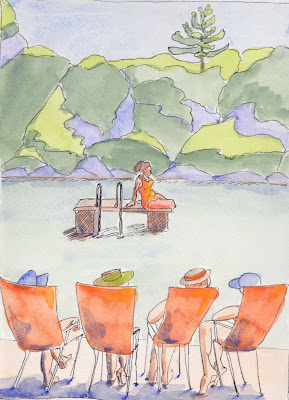One AMAZING source of inspiration
Perhaps the most important job of an illustrator is to come up with clever ways to communicate an idea. Illustration isn't as easy as "draw this bird so that people know the story is about a bird." It's more like "draw a chair, and communicate an idea about democracy from your drawing." Or, in an example I will cite later, use a drawing of tomatoes to make a comment about immigration.
I use a sketchbook to improve my drawing skills, work out compositions, and gather inspiration. I have been drawing almost daily for four years, and have filled up close to nineteen sketchbooks. I wasn't expecting my old drawings to be the resource that they have turned out to be.
Coming up with ideas is hard, especially when you are dealing with abstract concepts. I used to do word associations to try to generate ideas. Although a good concept, it isn't very satisfying practice. It's hard to go from words to pictures; better to start off with pictures. Doodling is one way to generate visual ideas. Looking at old sketches is another - one that I use often.
Because I try to draw every day, even if for only five minutes, my drawings cannot be "precious". They are more like a visual recording of my day. Often, I notice that mundane subjects can be pretty interesting.
In early 2017, I drew these tomatoes:
I noticed their labels - "produce de Mexico". Trump had just become president, and I knew that immigration and deportation were going to be big issues. As I drew, I made a note to myself: "these tomato labels could be important." I didn't know how, or if, I was going to use them. Then, one day, inspiration struck. The result: An illustration of a Mexican tomato family being deported.
Another day, I was at the town pond, sitting on my towel and drawing the landscape and the people. I noticed women sitting in their beach chairs, talking to each other.
Illustrators love to use repetition, so I decided to do an illustration with these women in their chairs, wearing different types of hats.
I didn't take their picture, or ask them to pose. I quickly sketched, and used these drawings (plus others), as inspiration for the piece above. A sketch can capture a gesture that is exciting and compelling. A labored drawing or photo often destroys that.
A drawing I did at the local mall gave me an idea for my current business card illustration. I drew a mannequin at a woman's clothing store.
Then, I thought of coupling this mannequin with a small child who mistakes the mannequin for her mother.
My husband told me a story how he, as a small child, had grabbed the wrong woman's coat at a department store. I have had sleepy children wonder over to me and embrace my leg, thinking that it belonged to their mother. These stories completed the image for me that had started with a simple sketch. I will continue to sketch, and use these drawings to tap into ideas that spring from my sketchbook.












